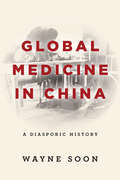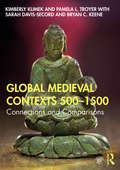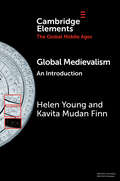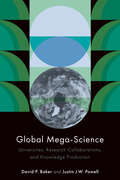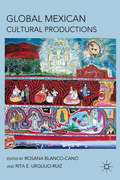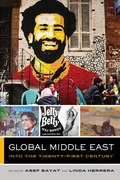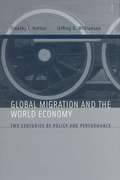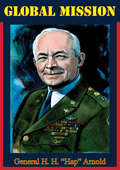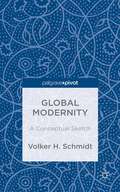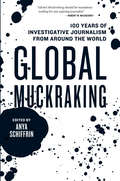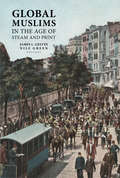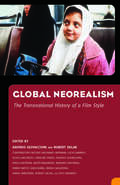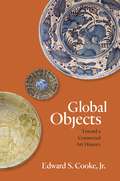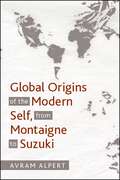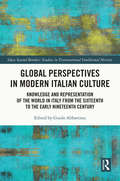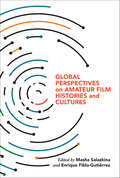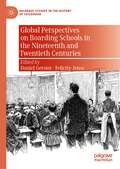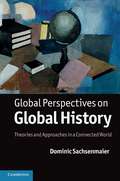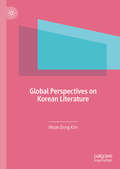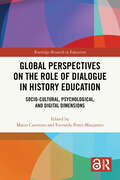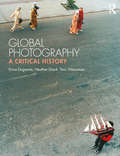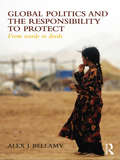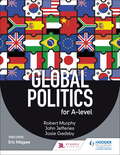- Table View
- List View
Global Medicine in China: A Diasporic History
by Wayne SoonIn 1938, one year into the Second Sino-Japanese War, the Chinese military found itself in dire medical straits. Soldiers were suffering from deadly illnesses, and were unable to receive blood transfusions for their wounds. The urgent need for medical assistance prompted an unprecedented flowering of scientific knowledge in China and Taiwan throughout the twentieth century. Wayne Soon draws on archives from three continents to argue that Overseas Chinese were key to this development, utilizing their global connections and diasporic links to procure much-needed money, supplies, and medical expertise. The remarkable expansion of care and education that they spurred saved more than four million lives and trained more than fifteen thousand medical personnel. Moreover, the introduction of military medicine shifted biomedicine out of elite, urban civilian institutions and laboratories and transformed it into an adaptive field-based practice for all. Universal care, practical medical education, and mobile medicine are all lasting legacies of this effort.
Global Medieval Contexts 500 – 1500: Connections and Comparisons
by Sarah Davis-Secord Kimberly Klimek Pamela L. Troyer Bryan C. KeeneGlobal Medieval Contexts 500–1500: Connections and Comparisons provides a unique wide-lens introduction to world history during this period. Designed for students new to the subject, this textbook explores vital networks and relationships among geographies and cultures that shaped medieval societies. The expert author team aims to advance a global view of the period and introduce the reader to histories and narratives beyond an exclusively European context. Key Features: Divided into chronological sections, chapters are organized by four key themes: Religion, Economics, Politics, and Society. This framework enables students to connect wider ideas and debates across 500 to 1500. Individual chapters address current theoretical discussions, including issues around gender, migration, and sustainable environments. The authors’ combined teaching experience and subject specialties ensure an engaging and accessible overview for students of history, literature, and those undertaking general studies courses. Theory boxes and end-of-chapter questions provide a basis for group discussion and research. Full-color maps and images illustrate chapter content and support understanding. As a result, this text is essential reading for all those interested in learning more about the histories and cultures of the period, as well as their relevance to our own contemporary experiences and perspectives. This textbook is supported by a companion website providing core resources for students and lecturers.
Global Medievalism: An Introduction (Elements in the Global Middle Ages)
by Helen Young Kavita Mudan FinnThe typical vision of the Middle Ages western popular culture represents to its global audience is deeply Eurocentric. The Lord of the Rings and Game of Thrones imagined entire medievalist worlds, but we see only a fraction of them through the stories and travels of the characters. Organised around the theme of mobility, this Element seeks to deconstruct the Eurocentric orientations of western popular medievalisms which typically position Europe as either the whole world or the centre of it, by making them visible and offering alternative perspectives. How does popular culture represent medievalist worlds as global-connected by the movement of people and objects? How do imagined mobilities allow us to create counterstories that resist Eurocentric norms? This study represents the start of what will hopefully be a fruitful and inclusive conversation of what the Middle Ages did, and should, look like.
Global Mega-Science: Universities, Research Collaborations, and Knowledge Production
by David P. Baker Justin J.W. PowellNever has the world been as rich in scientific knowledge as it is today. But what are its main sources? In accessible and engaging fashion, Global Mega-Science examines the origins of this unprecedented growth of knowledge production over the past hundred and twenty years. David P. Baker and Justin J.W. Powell integrate sociological and historical approaches with unique scientometric data to argue that at the heart of this phenomenon is the unparalleled cultural success of universities and their connection to science: the university-science model. Considering why science is so deeply linked to (higher) educational development, the authors analyze the accumulation of capacity to produce research—and demonstrate how the university facilitates the emerging knowledge society. The age of global mega-science was built on the symbiotic relationship between higher education and science, especially the worldwide research collaborations among networked university-based scientists. These relationships are key for scholars and citizens to understand the past, future, and sustainability of science.
Global Mexican Cultural Productions
by Rita E. Urquijo-Ruiz Rosana Blanco-CanoIn this book, the authors propose a multilayered reading of contemporary transnational cultural manifestations in which it is possible to recognize challenges and cultural strategies that transnational Mexican communities conceive in order to claim cultural, political and social agency.
Global Middle East: Into the Twenty-First Century (Global Square #3)
by Asef Bayat and Linda HerreraLocalities, countries, and regions develop through complex interactions with others. This striking volume highlights global interconnectedness seen through the prism of the Middle East, both "global-in" and "global-out." It delves into the region’s scientific, artistic, economic, political, religious, and intellectual formations and traces how they have taken shape through a dynamic set of encounters and exchanges. Written in short and accessible essays by prominent experts on the region, Global Middle East covers topics including God, Rumi, food, film, fashion, music, sports, science, and the flow of people, goods, and ideas. The text explores social and political movements from human rights, Salafism, and cosmopolitanism to radicalism and revolutions. Using the insights of global studies, students will glean new perspectives about the region.
Global Migration and the World Economy: Two Centuries of Policy and Performance
by Jeffrey G. Williamson Timothy J. HattonThis book is the first comprehensive economic assessment of world mass migration taking a long-run historical perspective, including north-north, south-south, and south-north migrations.
Global Mission
by General H. H. “Hap” Arnold"Hap" Arnold, Commander-in-Chief of the greatest Air Force the world has ever seen, tells the story of his life, of how our air power was developed and of the great decisions and operations of World War II."(Hap Arnold was) a dedicated officer in a specialized field,...and at the same time, a human being, a warm-hearted, loyal, mercurial, flamboyantly belligerent fellow who didn't care who he took on in battle."--Robert A. Lovett
Global Modernity. A Conceptual Sketch
by Volker H. SchmidtThis book introduces the concept of global modernity as a paradigm for the analysis of the contemporary era. Building on Parson's distinction between social, cultural, personal and organismic systems, it presents a four-dimensional scheme that aims to identify modernity's key structural components.
Global Movie Magazine Networks
by Eric Hoyt and Kelley ConwayA free ebook version of this title is available through Luminos, University of California Press’s Open Access publishing program. Visit www.luminosoa.org to learn more. This groundbreaking collection of essays from leading film historians features original research on movie magazines published in China, France, Germany, India, Iran, Latin America, South Korea, the U.S., and beyond. Vital resources for the study of film history and culture, movie magazines are frequently cited as sources, but rarely centered as objects of study. Global Movie Magazine Networks does precisely that, revealing the hybridity, heterogeneity, and connectivity of movie magazines and the important role they play in the intercontinental exchange of information and ideas about cinema. Uniquely, the contributors in this book have developed their critical analysis alongside the collaborative work of building digital resources, facilitating the digitization of more than a dozen of these historic magazines on an open-access basis.
Global Muckraking
by Anya SchiffrinCrusading journalists from Sinclair Lewis to Bob Woodward and Carl Bernstein have played a central role in American politics: checking abuses of power, revealing corporate misdeeds, and exposing government corruption. Muckraking journalism is part and parcel of American democracy. But how many people know about the role that muckraking has played around the world?This groundbreaking new book presents the most important examples of world-changing journalism, spanning one hundred years and every continent. Carefully curated by prominent international journalists working in Asia, Africa, Latin America, Europe, and the Middle East, Global Muckraking includes Ken Saro-Wiwa's defense of the Ogoni people in the Niger Delta; Horacio Verbitsky's uncovering of the gruesome disappearance of political detainees in Argentina; Gareth Jones's coverage of the Ukraine famine of 1932-33; missionary newspapers' coverage of Chinese foot binding in the nineteenth century; Dwarkanath Ganguli's exposé of the British "coolie" trade in nineteenth-century Assam, India; and many others.Edited by the noted author and journalist Anya Schiffrin, Global Muckraking is a sweeping introduction to international journalism that has galvanized the world's attention. In an era when human rights are in the spotlight and the fate of newspapers hangs in the balance, here is both a riveting read and a sweeping argument for why the world needs long-form investigative reporting.
Global Muslims in the Age of Steam and Print
by Nile Green James L. GelvinThe second half of the nineteenth century marks a watershed in human history. Railroads linked remote hinterlands with cities; overland and undersea cables connected distant continents. New and accessible print technologies made the wide dissemination of ideas possible; oceangoing steamers carried goods to faraway markets and enabled the greatest long-distance migrations in recorded history. In this volume, leading scholars of the Islamic world recount the enduring consequences these technological, economic, social, and cultural revolutions had on Muslim communities from North Africa to South Asia, the Indian Ocean, and China. Drawing on a multiplicity of approaches and genres, from commodity history to biography to social network theory, the essays in Global Muslims in the Age of Steam and Print offer new and diverse perspectives on a transnational community in an era of global transformation.
Global Neorealism: The Transnational History of a Film Style
by Saverio GiovacchiniContributions by Nathaniel Brennan, Luca Caminati, Silvia Carlorosi, Caroline Eades, Saverio Giovacchini, Paula Halperin, Neepa Majumdar, Mariano Mestman, Hamid Naficy, Sada Niang, Masha Salazkina, Sarah Sarzynski, Robert Sklar, and Vito ZagarrioIntellectual, cultural, and film historians have long considered neorealism the founding block of post-World War II Italian cinema. Neorealism, the traditional story goes, was an Italian film style born in the second postwar period and aimed at recovering the reality of Italy after the sugarcoated moving images of fascism. Lasting from 1945 to the early 1950s, neorealism produced world-renowned masterpieces such as Roberto Rossellini's Roma, città aperta (Rome, Open City, 1945) and Vittorio De Sica's Ladri di biciclette (Bicycle Thieves, 1947). These films won some of the most prestigious film awards of the immediate postwar period and influenced world cinema. This collection brings together distinguished film scholars and cultural historians to complicate this nation-based approach to the history of neorealism. The traditional story notwithstanding, the meaning and the origins of the term are problematic. What does neorealism really mean, and how Italian is it? Italian filmmakers were wary of using the term and Rossellini preferred "realism." Many filmmakers confessed to having greatly borrowed from other cinemas, including French, Soviet, and American. Divided into three sections, Global Neorealism examines the history of this film style from the 1930s to the 1970s using a global and international perspective. The first section examines the origins of neorealism in the international debate about realist esthetics in the 1930s. The second section discusses how this debate about realism was “Italianized” and coalesced into Italian “neorealism” and explores how critics and film distributors participated in coining the term. Finally, the third section looks at neorealism’s success outside of Italy and examines how film cultures in Latin America, Africa, Asia, and the United States adjusted the style to their national and regional situations.
Global Nollywood: The Transnational Dimensions of an African Video Film Industry (African Expressive Cultures)
by Matthias Krings and Onookome Okome“Reveals in fascinating detail the wild popularity, controversies, and complaints provoked by this film form . . . shap[ing] the media landscape of Africa.” —Brian Larkin, Barnard CollegeGlobal Nollywood considers this first truly African cinema beyond its Nigerian origins. In fifteen lively essays, this volume traces the engagement of the Nigerian video film industry with the African continent and the rest of the world. Topics such as Nollywood as a theoretical construct, the development of a new, critical film language, and Nollywood’s transformation outside of Nigeria reveal the broader implications of this film form as it travels and develops. Highlighting controversies surrounding commodification, globalization, and the development of the film industry on a wider scale, Global Nollywood gives sustained attention to Nollywood as a uniquely African cultural production.“Offers original material with respect to the transnational presence of Nollywood.” ?Moradewun Adejunmobi, University of California, Davis“Unveils a fascinating variety of the ways in which Nollywood cinema is viewed and interpreted.” ?Research in African Literatures“Delightfully entertaining yet appropriately erudite. . . . A welcome addition to the fields of film, media, African, and cultural studies.” —Cinema Journal“Highly recommended.” ?Choice“[T]he cumulative effect of [these] studies is to provide invaluable information for those wishing to keep up with where African cinema is today.” ?Journal of African History“Global Nollywood represents the most up-to-date research on Nollywood as a transnational cultural practice and is a must-read for scholars and students of African screen media.” —African Studies Review“Ground-breaking. . . . It proves that, in spite of appearing to be a niche market, Nollywood . . . can no longer be excluded from the canon of African cinema in the field of film studies.” ?African Affairs
Global Objects: Toward a Connected Art History
by Edward S. CookeA bold reorientation of art history that bridges the divide between fine art and material culture through an examination of objects and their usesArt history is often viewed through cultural or national lenses that define some works as fine art while relegating others to the category of craft. Global Objects points the way to an interconnected history of art, examining a broad array of functional aesthetic objects that transcend geographic and temporal boundaries and challenging preconceived ideas about what is and is not art.Avoiding traditional binaries such as East versus West and fine art versus decorative art, Edward Cooke looks at the production, consumption, and circulation of objects made from clay, fiber, wood, and nonferrous base metals. Carefully considering the materials and process of making, and connecting process to product and people, he demonstrates how objects act on those who look at, use, and acquire them. He reveals how objects retain aspects of their local fabrication while absorbing additional meanings in subtle and unexpected ways as they move through space and time. In emphasizing multiple centers of art production amid constantly changing contexts, Cooke moves beyond regional histories driven by geography, nation-state, time period, or medium.Beautifully illustrated, Global Objects traces the social lives of objects from creation to purchase, and from use to experienced meaning, charting exciting new directions in art history.
Global Origins of the Modern Self, from Montaigne to Suzuki
by Avram AlpertIn Global Origins of the Modern Self, from Montaigne to Suzuki, Avram Alpert contends that scholars have yet to fully grasp the constitutive force of global connections in the making of modern selfhood. Alpert argues that canonical moments of self-making from around the world share a surprising origin in the colonial anthropology of Europeans in the Americas. While most intellectual histories of modernity begin with the Cartesian inward turn, Alpert shows how this turn itself was an evasion of the impact of the colonial encounter. He charts a counter-history of the modern self, tracing lines of influence that stretch from Michel de Montaigne's encounter with the Tupi through the writings of Jean-Jacques Rousseau into German Idealism, American Transcendentalism, postcolonial critique, and modern Zen. Alpert considers an unusually wide range of thinkers, including Kant, Hegel, Fanon, Emerson, Du Bois, Senghor, and Suzuki. This book not only breaks with disciplinary conventions about period and geography but also argues that these conventions obscure our ability to understand the modern condition.
Global Perspectives in Modern Italian Culture: Knowledge and Representation of the World in Italy from the Sixteenth to the Early Nineteenth Century (Ideas beyond Borders)
by Guido AbbattistaGlobal Perspectives in Modern Italian Culture presents a series of unexplored case studies from the sixteenth to the twentieth century, each demonstrating how travellers, scientists, Catholic missionaries, scholars and diplomats coming from the Italian peninsula contributed to understandings of various global issues during the age of early globalization. It also examines how these individuals represented different parts of the world to an Italian audience, and how deeply Italian culture drew inspiration from the increasing knowledge of world ‘Otherness’. The first part of the book focuses on the production of knowledge, drawing on texts written by philosophers, scientists, historians and numerous other first-hand eyewitnesses. The second part analyses the dissemination and popularization of knowledge by focussing on previously understudied published works and initiatives aimed at learned Italian readers and the general public. Written in a lively and engaging manner, this book will appeal to scholars and students of early modern and modern European history, as well as those interested in global history.
Global Perspectives on Amateur Film Histories and Cultures
by Masha Salazkina and Enrique Fibla-GutiérrezFor too long, the field of amateur cinema has focused on North America and Europe. In Global Perspectives on Amateur Film Histories and Cultures, however, editors Masha Salazkina and Enrique Fibla-Gutiérrez fill the literature gap by extending that focus and increasing inclusivity. Through carefully curated essays, Salazkina and Fibla-Gutiérrez bring wider meaning and significance to the discipline through their study of alternative cinema in new territories, fueled by different historical and political circumstances, innovative technologies, and ambitious practitioners. The essays in this volume work to realize the radical societal democratization that shows up in amateur cinema around the world. In particular, diverse contributors highlight the significance of amateur filmmaking, the exhibition of amateur films, the uses and availability of film technologies, and the inventive and creative approaches of filmmakers and advocates of amateur film. Together, these essays shed new light on alternative cinema in a wide range of cities and countries where amateur films thrive in the shadow of commercial and conventional film industries.
Global Perspectives on Boarding Schools in the Nineteenth and Twentieth Centuries (Palgrave Studies in the History of Childhood)
by Felicity Jensz Daniel GersterIn the nineteenth and twentieth centuries, thousands of pupils attended boarding schools in various places across the globe. Their experiences were vastly different, yet they all had in common that they were separated from their families and childhood friends for a period of time in order to sleep, eat, learn and move within the limited spatial sites of the boarding school. This book frames these ‘boarding schools’ as a global and transcultural phenomenon that is part of larger political and social developments of European imperialism, the Cold War, and independence movements. Drawing together case studies from colonial South Africa, colonial India, Dutch Indonesia, early twentieth-century Nigeria, Fascist Spain, Ghana, Nazi Germany, nineteenth-century Ireland, North America and the Soviet Union, this edited collection examines the ways in which boarding schools extracted pupils from their original social background in order to train, mold and shape them so that they could fit into the perceived position in broader society. The book makes the broader argument that framing boarding schools as a global phenomenon is imperative for a deepened understanding of the global and transnational networks that linked people as well as ideas and practices of education and childhood in the nineteenth and twentieth centuries.
Global Perspectives on Global History
by Dominic SachsenmaierIn recent years, historians across the world have become increasingly interested in transnational and global approaches to the past. However, the debates surrounding this new border-crossing movement have remained limited in scope as theoretical exchanges on the tasks, responsibilities and potentials of global history have been largely confined to national or regional academic communities. In this groundbreaking book, Dominic Sachsenmaier sets out to redress this imbalance by offering a series of new perspectives on the global and local flows, sociologies of knowledge and hierarchies that are an intrinsic part of historical practice. Taking the United States, Germany and China as his main case studies, he reflects upon the character of different approaches to global history as well as their social, political and cultural contexts. He argues that this new global trend in historiography needs to be supported by a corresponding increase in transnational dialogue, cooperation and exchange.
Global Perspectives on Korean Literature
by Wook-Dong KimThis book explores Korean literature from a broadly global perspective from the mid-9th century to the present, with special emphasis on how it has been influenced by, as well as it has influenced, literatures of other nations. Beginning with the Korean version of the King Midas and his ass’s ears tale in the Silla dynasty, it moves on to discuss Ewa, what might be called the first missionary novel about Korea written by a Western missionary W. Arthur Noble. The book also considers the extent to which in writing fiction and essays Jack London gained grist for his writing from his experience in Korea as a Russo-Japanese War correspondent. In addition, the book explores how modern Korean poetry, fiction, and drama, despite differences in time and space, have actively engaged with Western counterparts. Based on World Literature, which has gained slow but prominent popularity all over the world, this book argues that Korean literature deserves to be part of the Commonwealth of Letters.
Global Perspectives on the Role of Dialogue in History Education: Socio-cultural, Psychological, and Digital Dimensions (Routledge Research in Education)
by Mario Carretero Everardo Perez-ManjarrezProviding the first volume-length exploration of the role that dialogue can play in history education classrooms, this book explores the socio-cultural, psychological, and digital dimensions of dialogic practice to promote research into historical thinking, historical consciousness, and critical thinking in educational settings.This book’s novel approach is in its analysis of dialogical processes in various international and intercultural educational contexts; chapters compare Israeli and Palestinian textbooks and classroom discussion and explore teachers’ challenges to shift monologic school culture, as well as approaches to enhancing dialogic practices both in US contexts and in several EU countries. Each case study provides an insight into the nature of dialogue as both shared historical inquiry and cultural practice. How can dialogue be promoted, and through what mechanisms? In what ways can dialogue contribute to democratic societies’ thriving and dealing with and overcoming conflicts about different views on the past? Ultimately, the book looks to foster a nuanced and complex understanding of history, prompting consideration of different perspectives and a collective approach to overcoming troubled pasts and trauma.Featuring a truly international set of contributions from established and emerging scholars, this book will appeal to scholars, researchers, and postgraduate students interested in the history of education, education policy and politics, and historiography more broadly. This book was made possible with the support of the EU project www.making-histories.eu (10108606), coordinated by the first author.
Global Photography: A Critical History
by Terri Weissman Heather Diack Erina DuganneThis innovative text recounts the history of photography through a series of thematically structured chapters. Designed and written for students studying photography and its history, each chapter approaches its subject by introducing a range of international, contemporary photographers and then contextualizing their work in historical terms. The book offers students an accessible route to gain an understanding of the key genres, theories and debates that are fundamental to the study of this rich and complex medium. Individual chapters cover major topics, including: · Description and Abstraction · Truth and Fiction · The Body · Landscape · War · Politics of Representation · Form · Appropriation · Museums · The Archive · The Cinematic · Fashion Photography Boxed focus studies throughout the text offer short interviews, curatorial statements and reflections by photographers, critics and leading scholars that link photography's history with its practice. Short chapter summaries, research questions and further reading lists help to reinforce learning and promote discussion. Whether coming to the subject from an applied photography or art history background, students will benefit from this book's engaging, example-led approach to the subject, gaining a sophisticated understanding of international photography in historical terms.
Global Politics and the Responsibility to Protect: From Words to Deeds (Global Politics and the Responsibility to Protect)
by Alex J. BellamyThis book provides an in-depth introduction to, and analysis of, the issues relating to the implementation of the recent Responsibility to Protect principle in international relations The Responsibility to Protect (RtoP) has come a long way in a short space of time. It was endorsed by the General Assembly of the UN in 2005, and unanimously reaffirmed by the Security Council in 2006 (Resolution 1674) and 2009 (Resolution 1894). UN Secretary-General Ban Ki-moon has identified the challenge of implementing RtoP as one of the cornerstones of his Secretary-Generalship. The principle has also become part of the working language of international engagement with humanitarian crises and has been debated in relation to almost every recent international crisis – including Sudan, Sri Lanka, Myanmar, Georgia, the Democratic Republic of Congo, Darfur and Somalia. Concentrating mainly on implementation challenges including the prevention of genocide and mass atrocities, strengthening the UN’s capacity to respond, and the role of regional organizations, this book introducing readers to contemporary debates on R2P and provides the first book-length analysis of the implementation agenda. The book will be of great interest to students of the responsibility to protect, humanitarian intervention, human rights, foreign policy, security studies and IR and politics in general.
Global Politics for A-level
by Robert Murphy John Jefferies Josie GadsbyExpand your students' political thinking and put global politics into context with this brand new textbook; created for the 2017 politics specifications. Combining up-to date commentary and analysis with case studies and features, this textbook will help develop an understanding of politics from the local to the international, revealing how political issues affect us all.- Comprehensive coverage of the latest developments in global politics - Analysis of the perspectives of liberalism and realism- Definitions of key terms and concepts to help clarify knowledge and understanding of political language- Exam focus sections at the end of each chapter to test and develop understanding of key topics, offering practice for short and essay questions
